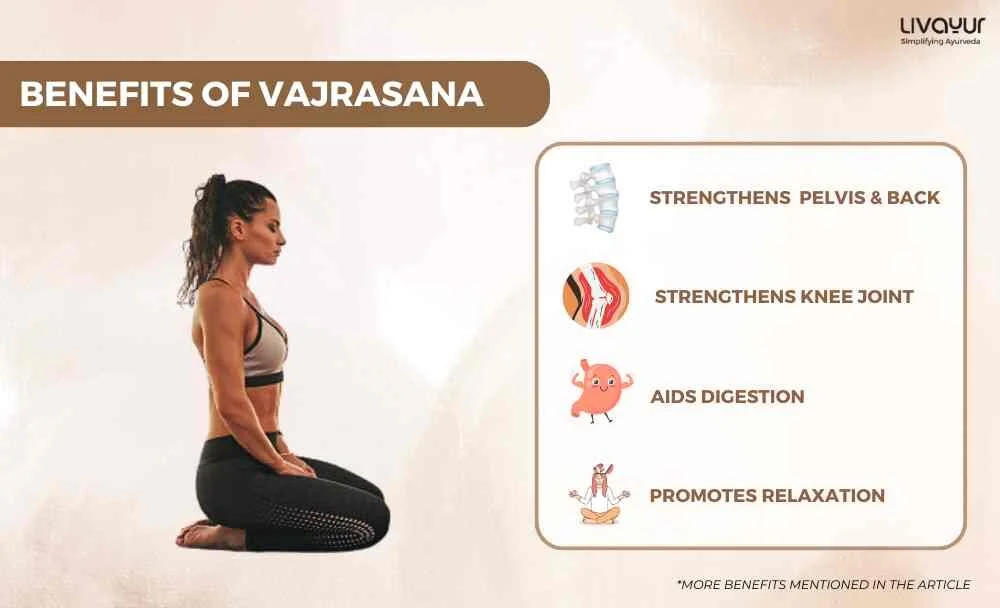
Vajrasana, also known as the thunderbolt pose, is a simple yet powerful yoga pose practiced for centuries. Whether you’re a seasoned practitioner or just starting, incorporating Vajrasana into your routine can positively impact your health and well-being.
This article looks at the health benefits of Vajrasana. We’ll also review the proper technique and modifications for practicing Vajrasana so you can easily incorporate it into your yoga practice.
So, grab your yoga mat, and let’s dive into the wonderful world of Vajrasana.
What is Vajrasana?
Vajrasana is a yoga posture involving kneeling on the floor with your legs folded underneath and your buttocks resting on your heels. [1] The word “Vajra” in Sanskrit means thunderbolt, while “Asana” means pose.
One thing that makes Vajrasana so special is that it is one of the few yoga poses that can be practiced immediately after a meal. [1] In fact, it’s recommended that you practice Vajrasana for at least 10-15 minutes after eating, as it helps improve digestion and relieve any discomfort or bloating. [1]
What are the health benefits of Vajrasana?
Vajrasana has a long list of health benefits. making it a worthy addition to any yoga practice. Here are some of the benefits of practicing Vajrasana:
1. Improves digestion
Vajrasana helps to improve digestion by increasing blood flow and circulation to the abdominal area. It helps relieve constipation, bloating, and other digestive issues. [1]

2. Alleviates back pain
Vajrasana is a great pose to reduce back pain, as it helps stretch and strengthen lower back’s muscles. [1]
3. Reduces stress and anxiety
Practicing Vajrasana can help reduce stress and anxiety by calming the mind and promoting relaxation. It can also help to improve focus and concentration. [2]

4. Strengthened knees and thighs
Regular practice of Vajrasana can help strengthen the knees and thighs, which can be especially beneficial for those with weak joints. [1]
5. Improves blood circulation
Vajrasana can help improve blood circulation throughout the body, which can positively impact overall health and well-being. [1]
How to do Vajrasana Pose Step by Step
Here’s a step-by-step guide to help you practice Vajrasana with proper technique: [1]
Step 1- Kneel on the floor with your knees and your feet pointing straight back.
Step 2 – Slowly lower your buttocks towards your heels, keeping your back straight and your shoulders relaxed.
Step 3 – Place your hands on your knees or thighs, and focus on breathing deeply and evenly.
Step 4 – If you feel comfortable, hold the pose for 5-10 minutes or longer.
Step 5 – To release the pose, slowly lift your buttocks off your heels and return to kneeling.
If you experience difficulty keeping your buttocks on your heels, you can place a cushion or yoga block underneath your buttocks for support. Remember, the key to getting the most out of Vajrasana is to focus on your breath and fully relax into the pose. With regular practice, you’ll start to feel the many benefits of Vajrasana in both your body and mind.
Precautions to keep in mind for Vajrasana
While the Vajrasana posture is generally a safe pose for most people, there are a few precautions you should keep in mind before practicing it:
- Avoid practicing Vajrasana if you have a knee injury or any knee-related issues. If you experience pain or discomfort while practicing the pose, stop immediately and consult a healthcare professional.
- If you have any ankle or foot injuries, you may want to place a cushion or yoga block underneath your ankles for support.
- If you experience any discomfort or pain in your ankles, knees, or lower back while practicing Vajrasana, adjust the pose or come out of it altogether.
Remember, Vajrasana yoga aims to promote overall health and well-being. So, always listen to your body and practice within your limits. If you have any questions about practicing Vajrasana, consulting with a yoga instructor or healthcare professional is always a good idea.
FAQs About Vajrasana
1. What is Supta Vajrasana?
Supta Vajrasana is also known as the reclined thunderbolt pose. It is a variation of Vajrasana where the practitioner reclines backward with the support of the forearms, elbows, and head on the floor.
2. What is the Vajrasana position?
The Vajrasana position is a seated yoga posture involving kneeling on the floor with the knees together and the feet flat against the ground. It is also known as the diamond pose, thunderbolt pose, or adamantine pose.
3. What are the Supta Vajrasana benefits?
Some benefits of Supta Vajrasana include improved digestion, increased hip and thigh flexibility, strengthened lower back muscles, and improved blood circulation. It can also calm the mind and reduce stress and anxiety.
Conclusion
From improved digestion and circulation to increased flexibility and mental clarity, Vajrasana can help you achieve greater health and well-being. And the best part is that Vajrasana is simple and easy to practice, making it accessible to people of varied age groups and fitness levels.
Remember, the key to getting the most out of Vajrasana is to practice it regularly and with mindfulness. Focus on your breath, allow yourself to fully relax into the pose, and practice within your limits. With dedication and patience, you’ll start to experience the many benefits of Vajrasana in your body and mind.
Disclaimer:
The information provided here is not intended to replace professional advice or treatment.
References:
- Review and Importance of Vajrasana in Daily Life. February 2021
- Common Benefits of Prayer and Yoga on Human Organism. 2016

















